Are tiny bugs buzzing around your fresh produce? Chances are, you’ve got fruit flies! Don’t worry, these common kitchen pests are easily dealt with. Getting rid of fruit flies doesn’t require expensive solutions or harsh chemicals. In fact, you likely have everything you need right in your kitchen to make effective fruit fly traps.
Recently, we faced a fruit fly invasion at home for the first time in years. This unexpected pest problem became the perfect opportunity to put various fruit fly elimination methods to the test. After thorough experimentation and careful notes, we’re excited to share the best homemade fruit fly traps and guide you through creating them.
These DIY traps are simple to assemble using natural, household ingredients, making them both eco-friendly and budget-friendly. If you’re feeling compassionate, we’ll even cover humane fruit fly trap options that allow you to release them outdoors. Plus, we’ll provide essential tips to prevent future fruit fly infestations, keeping your kitchen pest-free.
Understanding Fruit Flies
Fruit flies are small, winged insects known for their attraction to ripe and fermenting fruits and vegetables. True to their name, they are drawn to sugary substances, including fermenting beverages like beer, wine, and juice. You’ll often find them congregating around fruit bowls, garbage disposals, trash cans, and even sink drains. They are about the size of a grain of rice, with a tan or brownish body and distinctive red eyes, resembling miniature houseflies. Fruit flies are most prevalent during warmer months, particularly summer and late fall, coinciding with fruit harvest seasons.
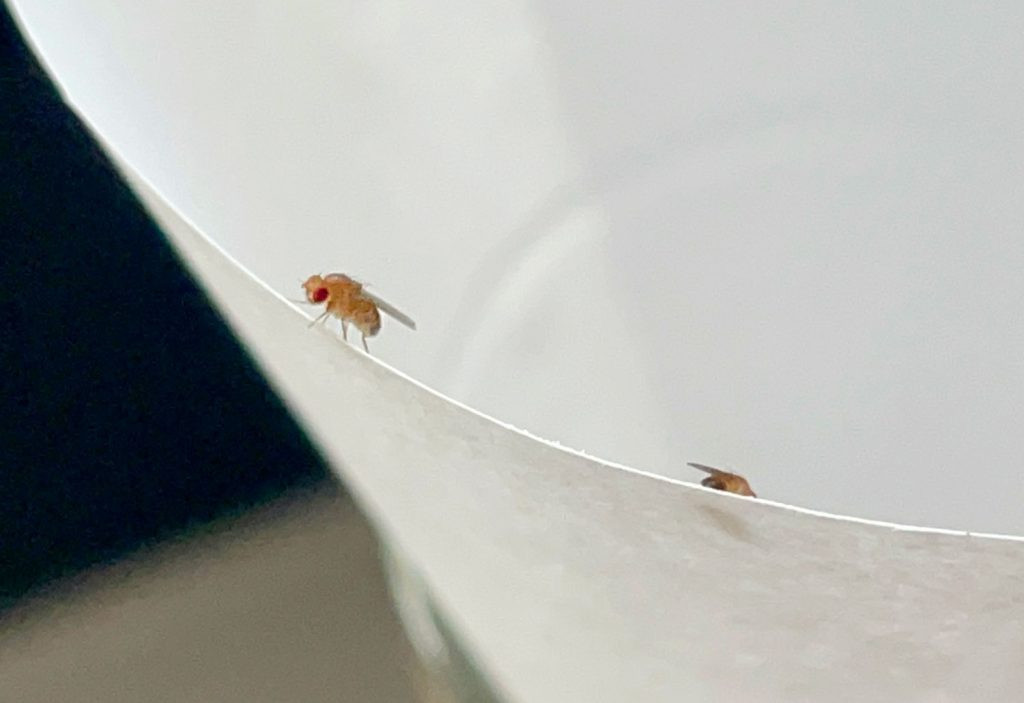 Close Up Of Fruit Fly On Paper Funnel
Close Up Of Fruit Fly On Paper Funnel
A fruit fly infestation often begins with just a few individuals hitching a ride indoors on fruits or vegetables. However, female fruit flies are prolific breeders, capable of laying hundreds of eggs in their short lifespan. These eggs can hatch in as little as 12 hours, and the flies can reach adulthood within days. This rapid life cycle explains how a small number of fruit flies can quickly escalate into a major infestation. Prompt action is key to effective fruit fly control.
Identifying Fruit Flies: Fruit Flies vs. Fungus Gnats vs. Drain Flies
Fruit flies are frequently mistaken for other small household insects, particularly fungus gnats and drain flies. While all three are small flying pests, accurate identification is crucial for choosing the most effective elimination strategy. The easiest way to differentiate them is by observing their location and physical resemblance to larger insects.
- Fruit Flies: Resemble tiny flies and are found near fruit, garbage, and other decaying food sources.
- Drain Flies: Look like small, fuzzy moths and are typically spotted near sinks and drains.
- Fungus Gnats: Appear similar to small mosquitoes and are commonly found around houseplants, as they breed in moist potting soil.
If you’re uncertain about the type of pest you’re dealing with, try one of the traps described below. If it attracts the insects in your home, you’re likely dealing with fruit flies.
4 Simple DIY Fruit Fly Traps
Eradicating fruit flies is neither complicated nor costly. You only need a few common household items and a bit of patience. The principle behind each trap is simple: attract the fruit flies and prevent their escape. We tested the following 4 DIY methods and identified a clear winner. Since each method utilizes items you probably already have, trying multiple approaches can be beneficial. Think of it as a fun, mini-science experiment in your kitchen! Here are the 4 DIY fruit fly traps we experimented with:
- Funnel Trap
- Plastic Wrap Trap
- Dish Soap Trap
- Rotting Fruit Trap
We’ll delve into the details of each method below and share our findings. Keep in mind that some traps work faster than others, and complete eradication may take several days, regardless of the technique you choose.
#1: The Paper Funnel Fruit Fly Trap
This trap design lures fruit flies into a container through a small opening at the bottom of a paper funnel. The flies are attracted inside but struggle to escape through the narrow funnel opening.
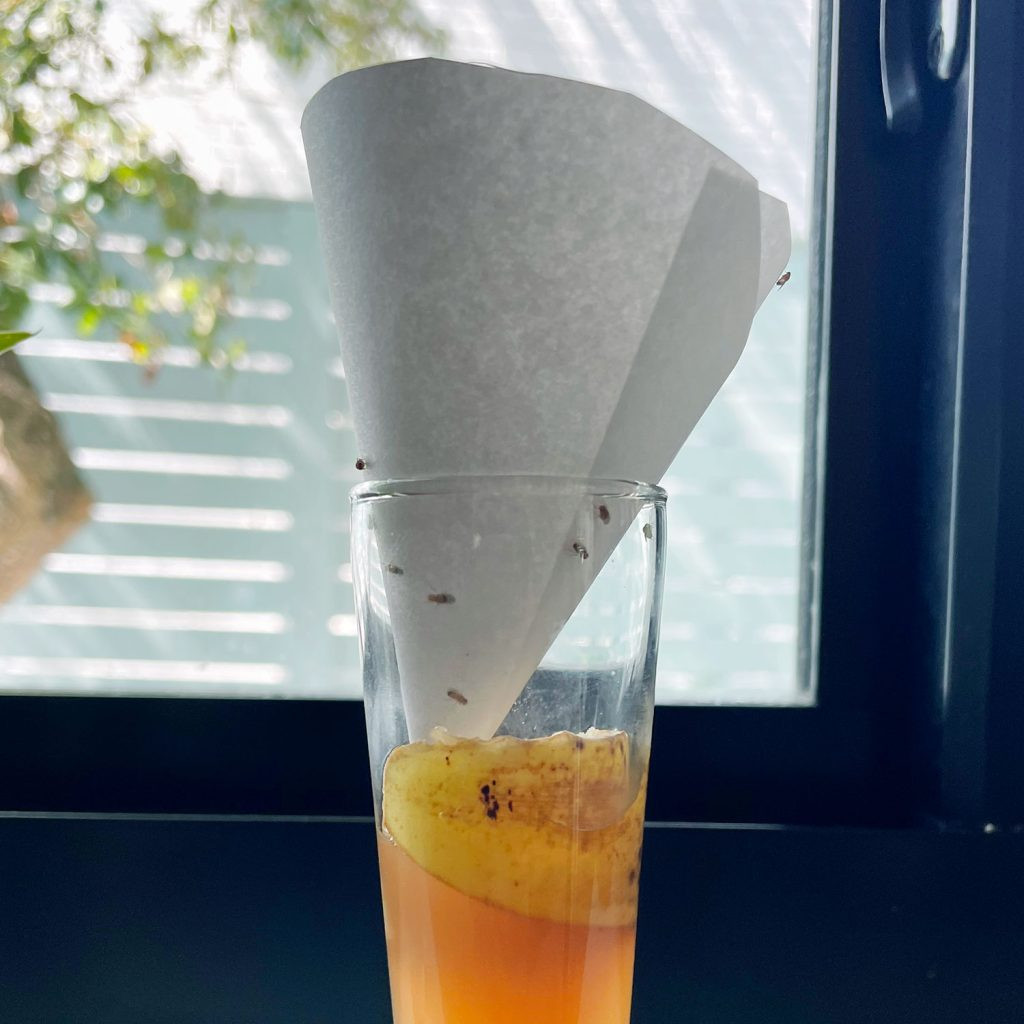 DIY Fruit Fly Trap With Paper Funnel
DIY Fruit Fly Trap With Paper Funnel
Materials:
- Small clear jar, cup, or container (narrow opening preferred)
- Paper or cardstock
- Tape
- Scissors
- Apple cider vinegar (ACV)
Instructions:
- Select a Container: Choose a small, clear container like a repurposed food jar or plastic bottle. A narrow opening is advantageous for this method.
- Add Apple Cider Vinegar: Pour a small amount of apple cider vinegar, old beer, or wine into the container. These liquids act as effective fruit fly attractants.
- Create a Paper Funnel: Roll a piece of paper or cardstock into a cone shape with a very small hole at the tip. Secure the cone shape with tape. You can create the small opening by cutting the tip of the cone if that’s easier. The hole only needs to be about the size of a grain of rice.
- Position the Funnel: Place the paper funnel into the container opening. Adjust the funnel as needed so it sits securely on the rim without touching the liquid bait. Ensure there are no gaps around the funnel’s edge that would allow flies to escape.
- Humane Option (Outdoor Release): To release trapped fruit flies, carefully carry the entire trap outdoors, keeping the funnel in place to prevent escape. Once outside, remove the funnel to allow the flies to fly away.
While a store-bought funnel could be used, the opening at the bottom may be too large, potentially allowing captured fruit flies to escape.
#2: The Plastic Wrap Fruit Fly Trap
Similar to the funnel trap, this method uses apple cider vinegar as bait. Fruit flies enter the trap through tiny holes poked in plastic wrap stretched tightly over the container opening but find it difficult to exit.
Materials:
- Small clear jar, cup, or container
- Rubber band
- Plastic wrap or plastic bag
- Toothpick
- Apple cider vinegar (ACV)
Instructions:
- Choose Your Container: Select a small, clear jar, cup, or glass container. Almost any size container will work. Clear containers make it easier to monitor trap effectiveness, but even an old can will suffice.
- Pour in Apple Cider Vinegar: Add apple cider vinegar to the container. The scent will attract fruit flies effectively. Old beer or wine are also suitable alternatives, but regular white vinegar is not as effective.
- Cover with Plastic Wrap: Stretch plastic wrap tightly over the container opening and secure it with a rubber band. Saran wrap works well, or you can use a piece cut from a plastic bag.
- Poke Small Holes: Use a toothpick to create a few small holes in the plastic wrap top. A few holes are sufficient, just ensure they are large enough for a fruit fly to enter.
- Humane Option (Outdoor Release): To release trapped fruit flies, carefully take the trap outside without removing the plastic wrap. Once outdoors, remove the plastic wrap to let the flies escape.
Alternatively, you can adapt this method using a metal jar lid. Use a mason jar or old food jar with a metal lid. Puncture a small hole in the lid using a hammer and nail instead of using plastic wrap.
#3: The Dish Soap Fruit Fly Trap
This fruit fly trap is even simpler, requiring no cover. It utilizes the surface tension of soapy water to trap fruit flies. Note: This method is not designed for humane release, as the soap will trap and kill the flies.
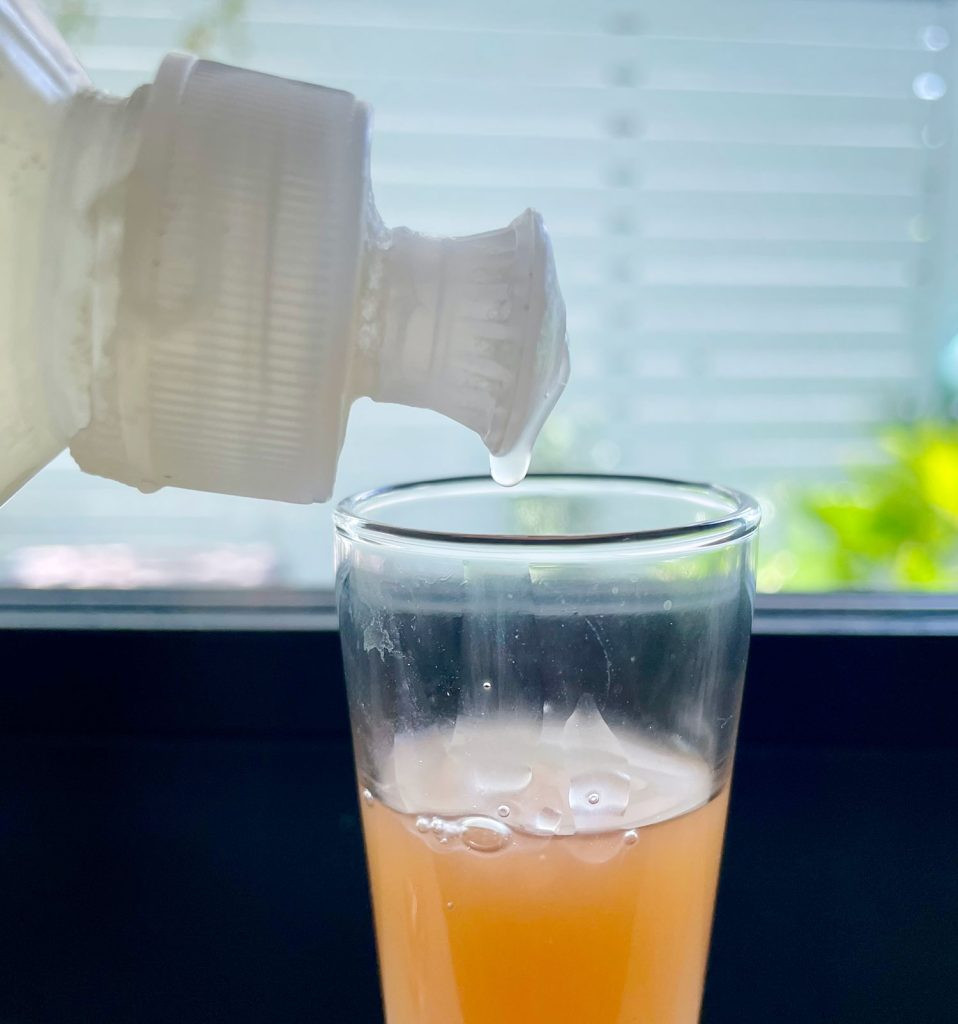 Dripping Dish Soap Into Apple Cider Vinegar For DIY Fruit Fly Trap
Dripping Dish Soap Into Apple Cider Vinegar For DIY Fruit Fly Trap
Materials:
- Small container, bowl, or dish
- Dish soap
- Apple cider vinegar (ACV)
Instructions:
- Pour Apple Cider Vinegar: Pour apple cider vinegar into the bottom of a small container, bowl, or dish. The sweet scent will attract fruit flies.
- Add Dish Soap and Mix: Add several drops of dish soap to the apple cider vinegar and gently mix. The soap breaks the surface tension of the liquid. Fruit flies will be attracted to the vinegar, land on the surface, and become trapped by the soapy mixture.
For enhanced effectiveness, you can combine this dish soap method with the plastic wrap or funnel traps. Simply add a few drops of dish soap to the apple cider vinegar before covering the container. This provides an additional trapping mechanism.
#4: The Rotting Fruit Fruit Fly Trap
We also experimented with traps that substituted apple cider vinegar with an even more irresistible lure for fruit flies: actual rotting fruit!
Materials:
- Small glass jar, cup, or container
- Plastic wrap or paper funnel (depending on your chosen trap style)
- Small piece of overripe fruit, such as banana peel or apple slice
To create a rotting fruit trap, simply replace the apple cider vinegar in either the Plastic Wrap Trap or Funnel Trap with a piece of banana peel, apple slice, or peach. You can also combine fruit with apple cider vinegar for a potent attractant. Be sure to replace the fruit every day or two to prevent unpleasant odors in your kitchen.
Determining the Best Fruit Fly Trap
As shown in the photos, we set up four different DIY traps to compare their effectiveness. The homemade traps we tested were variations combining different techniques:
- Plastic Wrap Trap with banana peel
- Funnel Trap with ACV + banana peel
- Plastic Wrap Trap with ACV + dish soap
- Dish Soap Trap with ACV
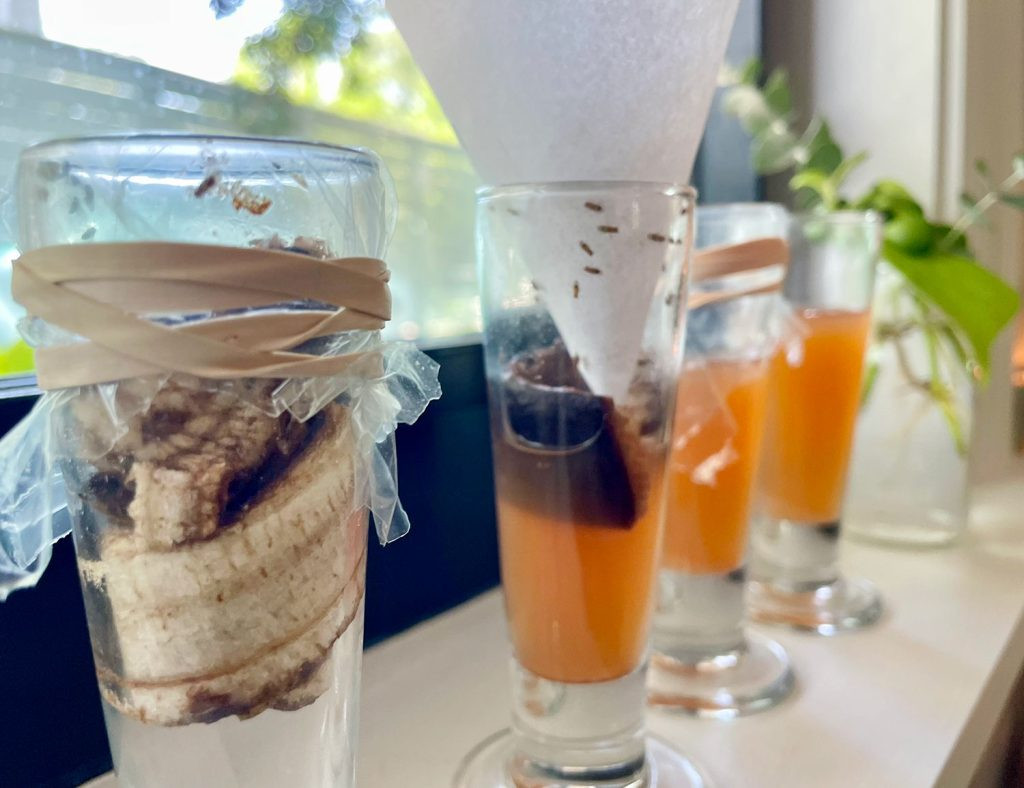 4 DIY Fruit Fly Traps Close Up
4 DIY Fruit Fly Traps Close Up
Our results indicated that the type of bait was more crucial than the trap design. Traps using banana peel significantly outperformed those using only apple cider vinegar. While the two Plastic Wrap Traps were nearly identical in construction, the one baited with banana peel caught dramatically more fruit flies than the ACV and soap trap. Perhaps apple cider vinegar is less appealing when real fruit is nearby?
Therefore, we recommend adding a piece of fruit to any DIY fruit fly trap you create. We slightly preferred the plastic wrap trap due to its ease of assembly and stability. We accidentally bumped the funnel trap, releasing some trapped flies back into the kitchen – oops!
What is the Most Effective Fruit Fly Bait?
Intrigued by the success of fruit scraps, we extended our experiment to determine the most effective fruit bait. We tested three readily available fruits: banana peel, apple slices, and a strawberry. Each fruit was placed in a separate Plastic Wrap Trap and positioned side-by-side on the kitchen counter for 24 hours.
While the banana peel initially seemed promising (it was the ripest at the start), the fruit flies were ultimately most attracted to the strawberry. The banana peel still captured a good number of flies, but the strawberry, as it became more fermented, attracted even more. Interestingly, the apple slices caught virtually no fruit flies!
Store-Bought Fruit Fly Trap Options
If DIY traps aren’t working for you, or if you prefer a ready-made solution, numerous commercially available fruit fly traps are effective. These store-bought traps have overwhelmingly positive reviews and are typically inexpensive, often under $20. They might be a worthwhile option if you want a trap that targets a broader range of flying insects or prefer a more discreet appearance compared to DIY traps.
 Collage of Storebought Fruit Fly Traps
Collage of Storebought Fruit Fly Traps
During our experiment, we purchased a pack of Terro Fruit Fly Traps to compare their performance against our homemade traps. We placed a Terro trap next to our banana and strawberry traps for 24 hours to assess which performed best.
Again, our homemade strawberry trap proved most effective, closely followed by the banana peel trap. The store-bought trap caught only a single fruit fly during this initial 24-hour period. HOWEVER…
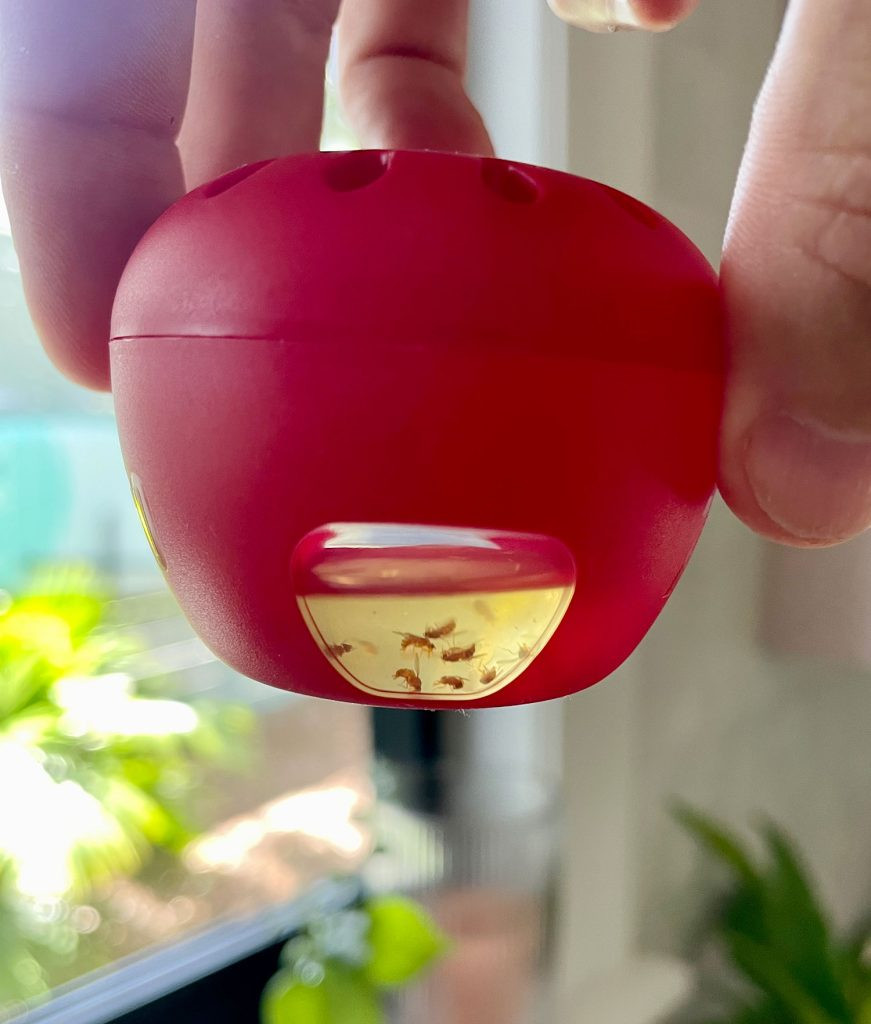 Terro Fruit Fly Trap With Dead Fruit Flies Visible
Terro Fruit Fly Trap With Dead Fruit Flies Visible
To ensure a fair comparison, we discarded our DIY traps and left the store-bought Terro trap in place for another 24 hours. Over this extended period, the Terro trap effectively captured a significant number of fruit flies, as pictured above. So, while store-bought traps are effective, they may not work as quickly or aggressively as homemade traps, particularly those baited with fruit. Our conclusion? Store-bought traps are a good choice if you desire a more inconspicuous solution, especially for long-term placement. However, for rapid fruit fly elimination, homemade traps are the superior choice!
Preventing Fruit Flies: Key Strategies
While eliminating fruit flies is relatively straightforward, preventing an infestation in the first place is ideal. Here are simple preventative measures to keep fruit flies from becoming a problem in your home:
- Maintain Clean Kitchen Surfaces: Regularly wipe down kitchen counters, stovetops, tables, and any surfaces that might accumulate food residue or spills. Fruit flies are particularly attracted to fruit, sweet liquids, and alcohol, so promptly clean up any spills.
- Dispose of Trash Regularly: Food scraps left in your garbage can quickly become a fruit fly breeding ground, especially in warmer weather. Empty your trash cans frequently, ideally daily.
- Manage Overripe Fruit: Monitor your fruit bowl for ripening or decaying fruits like apples and bananas. Dispose of overripe fruit promptly before they attract fruit flies.
- Wash Produce Immediately: Washing fruits and vegetables as soon as you bring them home from the grocery store can remove any fruit fly eggs or larvae that may be present. (Note: Berries may spoil faster if washed before storing, so wash them just before use).
- Refrigerate Produce When Possible: Fruit flies thrive in warmer temperatures and are less active in the cold. Storing fruits and vegetables in the refrigerator can deter fruit flies.
- Clean Sink Drains Regularly: Food debris trapped in sink drains can attract fruit flies. Run your garbage disposal regularly and flush drains with hot water and a drain cleaner periodically to eliminate food buildup.
Finally, don’t panic if you spot fruit flies in your home. While it’s important to act quickly to prevent a full-blown infestation, the solutions described in this guide are easy, effective, and fast-acting. You might even find yourself enjoying a bit of “fruit fly science” in the process, just like we did!
This post contains affiliate links, so we may earn a small commission when you make a purchase through links on our site at no additional cost to you.